Saturday was a decently long day out in the shop, probably about 4.5 hours total. I got a lot done, so I'll document it here.
The first thing I did was to correct my "oopsie" as mentioned a couple of nights ago -- specifically, re-adding the upper bracket to the top end of the
lower wiring harness. I had to remove all of the connectors behind the CAN box, remove the three-pin plastic connector, slide the upper bracket onto the top of the wiring harness bundle, and then re-install the plastic starter connector, and then re-connect the ring terminals and reconnect the three-pin plug into the starter connector. As said, this was about a 15-20 minute job. Not too big of a deal.
Secondly, I decided to take a diversion, and pursue a couple of "peripheral" tasks while I had fairly easy access to things. Specifically, this was the windshield wiper, and the water drain system at the base of the windshield. Working on both of these took me about 3 hours, but it was worth it given the results, and the correction of a few small issues that I found.
As far as I know, I have never lubricated the windshield wiper mechanism on the car, in the 18 years I have owned it. So, I decided to remove the wiper mechanism and clean it up, and at least lubricate the external joints. I did not remove the motor, nor did I remove and disassemble the internal gear mechanism -- I didn't see the point to do this, but certainly will if and when the time comes. However, the external rods and levers were all dry, and the center post that raises and lowers the wiper at the center of its arc was very much dry and in need of lubrication.
The wiper and motor mechanism is held onto the car with four 10mm nuts. These are all easy to get at -- two at the passenger side end, and two nuts parallel the to the ground on either side of the wiper's center pivoting mechanism. In the photos below, I am removing three of the four 10mm nuts.

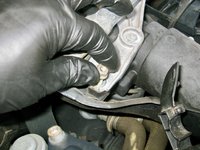


After removing the nuts, there is a metal spring clip in the center that binds the cast wiper mechanism to the car's structure. It is insulated via a rubber pad, which you can see inside the spring clip in the photos below.



After you remove the fourth 10mm nut (below), you can lift the entire wiper mechanism out of the car.

Here is what things look like with the wiper mechanism out. You can see that there is a little wear on the fresh air flap door -- some of the foam is worn away. There was a fabric covering over it that had fallen off, and was wadded up and sitting on top of the blower motor area. I need to think about what I need to do, in the future, to re-cover this fresh air flap door with new foam or covering, but that is a task for another day.

A few views of the wiper mechanism, as removed from the car. You can see plenty of dust and dirt adhering to the bottom of the mechanism, and motor area.


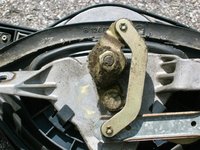
Next, you want to remove the wiper itself from the assembly. To do this (on later W124s), you lift/flip up the short cap at the base of the wiper. It should tilt up, and then you can remove it. This will expose a 5mm Allen bolt. This bolt is what holds the base of the wiper arm, to the pivoting wiper mechanism.

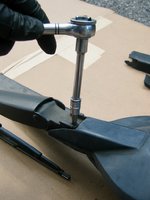

After you've removed the 5mm bolt, you can gently and slowly separate the wiper arm from the rotating mechanism by pulling steadily. It will come off with a few small back-and-forth wiggles.
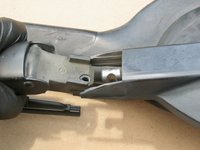
After you've separated the wiper arm from the reset of the mechanism, you can lift off the large cap that covers the center of the mechanism. It snaps on from the two edges, and you can release it by running your fingers around the edges of the cap to release the plastic catches.
GSXR EDIT: This plastic cap is only used on late wipers, as of early 1994 USA model year production. Older models have a metal cap that *does not* snap off, it is fastened with screws from the back side, and is far more difficult to remove. My 07/1994 production E500 has the non-removable metal cap.

When the cap is removed, this is what you see -- the center post that extends the wiper arm up and down. You can see the old grease (yellow grease) on the sides of the post, where it goes through the housing. I spent the next 30 minutes removing all of the old grease, and then lubricating ALL of the pivot points and arms on the top and underside of the wiper mechanism with fresh synthetic grease, applied with a syringe to the exact points where it is needed.
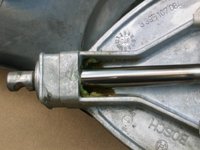
After lubricating everything well, I set the wiper mechanism aside, so that I could tackle the next job -- the rebuilding and refurbishment of the water drain mechanism at the base of the windshield. I had removed this five-piece item a few days ago, and set it aside in the garage while I decided what to do with it. Over the course of a few days, I decided to totally refurbish it as best I could, as there were a couple of aspects to it that needed my attention.
First, as you can see below, after removing the windshield wiper, you can see that where was A LOT of dirt and detritus at the base of the windshield, including in the plastic channel into which the rubber windshield wiper side-seals fit into. This led to a situation where my rubber side-pieces didn't press in and hold as well as they should. There was a lot of dirt, leaves, pine needles and other crud in the plastic channel. So, I got my shop vac out, and a thin flat-blade screwdriver, and I cleaned out the channels, and nearby leaves and dirt at the base of the windshield, and vacuumed it up with the shop vac. Doing this will help the rubber side pieces of the windshield wiper seat MUCH better once I re-install it. The two photos below show the sorry condition of the area, before I cleaned up the channels.

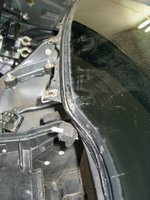

Next, I concentrated on the plastic water drain channels themselves. The channels' sealing edges to the inner firewall had some very old and sticky/dilapidated sealing foam. I removed this foam from the bottoms of the plastic water drain channels, and using some 1/4" adhesive foam that I purchased from Home Depot (Frost King brand, $6.49 for 10 feet), I rolled new foam into the positions where the old foam had been. On the inner firewall center piece (third and fourth photos below), there is a small thin slot into which foam had been pressed from the factory. I painstaking removed this pressed-in foam, and then pressed in (using a plastic screwdriver blade) a new length of foam.


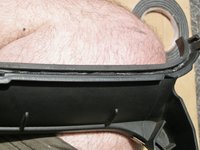


I also had one broken piece of the water drain channels -- the passenger-side large piece. The plastic-welds had come undone on this piece, and this allowed the mesh screen to pop free. I don't know when this had happened, and while not 100% detrimental to the operation of the drainage system, I wanted to have the mesh screen properly affixed into place. So, I got a spare part out of my deep parts stock, cleaned it up, and then added foam to it (per the above steps).
I also had a side piece, on the driver's side (the side piece where the water drains along the bottom of the windshield and down into the side drain at the fender) that was missing one of the small flanges underneath that help secure it to the larger piece with the mesh screen. Again, not a 100% detrimental thing, as the side piece is well-secured to the car, but also not 100% correct and as the factory intended it. So I got a spare piece out of my parts stock, and replaced it. You'll see in a couple of minutes the importance of this "flange" that I mention.
Here's what the "refurbished" water drain system looked like, after I'd finished cleaning and re-sealing it. I basically cleaned it enough so that there was no loose dirt or crud on it -- not a concours-style cleaning. I just wanted to make sure it was 100% complete, intact, and functional again.

After working over the water drain channel system, it was time to begin re-instaling the freshly lubricated windshield wiper system. Installation is largely the reverse of removal -- four 10mm nuts, and the center clip


After I re-installed the windshield wiper, it was time to renew the cabin filters. Before I did this, I took a plastic razor blade and removed some of the left-over old foam that had adhered to the top of the inner firewall. Then I took my shop vac, and gave the entire area a good Hoovering to pick up any leaves, foam pieces, Texas pine needles, and any other crap. This included the blower motor, inner firewall and cabin filter area. Then I installed the two cabin filters and seated them appropriately (one photo didn't totally turn out, sorry).




Then I attached the center clip for the windshield washer mechanism.

Then it was time to begin re-installing the plastic water drain system. This is fairly easy with the windshield wiper mechanism installed -- although you do need to lift the bottom of the rounded rubber seal at the bottom of the wiper pivot up a little bit, so you can fit in the center part of the water drain system (as shown in the two photos below.


From there, you just use your sheet metal screws to attach the center pieces to the car's body and firewall. There are 5-6 screws securing the two pieces. I popped the removable center drain back in.



Then it was time to add the side pieces. Each of these are held in by two sheet metal screws, and are attached similarly to the large plastic center pieces. Be sure to tuck the spouts at the ends of the side pieces into the rubber drain hoses below the corners of the windshield, when you are re-installing the side pieces !!

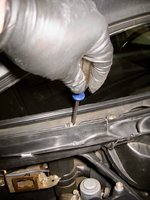
Here's what things should look like, with everything installed.
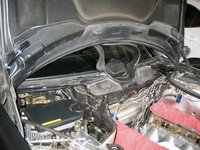
The last step is to add the white plastic pieces to the underside of the side/center pieces. Remember the "flange" on the side piece that I spoke about earlier? Well, each side piece has a small "T"-shaped flange that projects downward through a small hole in the end of the center piece. This flange helps secure the center and side pieces together using a "U"-shaped, white plastic clip, as shown below. On my car, BOTH of these clips were missing. Fortunately, I had three of them in my deep-parts stock, and I was able to re-install them by pushing them in over the flange, to lock the side and center pieces together. The third and fourth photos below, show the passenger and driver's side white clips installed. Note that these clips can be brittle with age, so be careful and DO NOT stress them. They push straight on, and if everything is properly aligned, they should push on quite easily.




And, the finished product -- a completely re-furbished and re-installed windshield wiper and rain drain channel system. Something I've wanted to do for a long time.
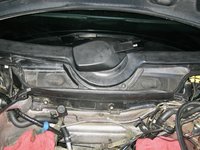
The latter hour or so of my time out in the shop, was spent re-connecting the connections of the lower wiring harness to the starter, and re-installing the two heat shields that protect the starter and harness connections, and the passenger side tie rod and ball joint/boot, from the hot exhaust manifold and downpipe. Fortunately this was relatively straightforward. I had already installed the 13mm nut that held the wiring harness connector to the starter's large terminal, so all I needed to re-connect was the small Philips head screw that held the harness's solenoid wire to the starter. This took a bit of effort, but I eventually got it. One tip -- it's much easier to do this job of attaching the starter connections with a non-gloved hand, as you can get a better "feel" for things with a bare hand.
After tightening the connections, I re-installed the heat shields (two 10mm bolts with the tie rod heat shield; two 10mm bolts + one 10mm nut with the starter heat shield), and then re-attached and tightened the steering shock (17mm nut and bolt).
One thing I have found with the lower wiring harness, at least with mine. I had purchased my lower wiring harness back in 2014, when I was living in Texas. Since then, it has been in the original plastic bag that I received it in. However, in a couple of places, the outer rubber sheathing of the harness started cracking. Not the wiring or insulation -- but rather the outer shrink-wrapped plastic sheathing that surrounded the wires of the harness. To combat this, as I installed the harness, I wrapped the harness in these places in high-temperature, high-quality 3M electrical tape (I probably should have used the TESA fabric wiring harness tape) in the places where the sheathing was breaking down. I don't know why it did this, but it did. Doesn't look great, but it is what it is. Here in the below photo, you can see where I wrapped the harness with the electrical tape.

Don't know if anyone else has experienced this (or had a harness sitting on the shelf for 5-6 years like I did), but I'd be interested in any observations or experiences you may have about this. Again -- not detrimental in any way to the harness itself, but at the same time a bit disappointing. I didn't have the proper items at hand to heat-shrink the harness with new sheathing -- which in an ideal world would have been the best thing to do. We'll see how well my electrical tape fix works.
After doing all of that, I decided to call it a day. The next task will be to drain the torque converter and transmission, and replace the transmission fluid and filter. At the same time, I will replace the two transmission cooler hoses in at the front of the engine. After I finish the transmission service, I should generally be done with all of the required work under the car.



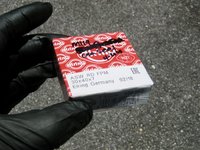

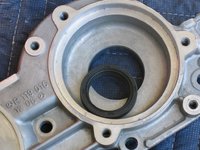
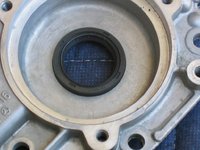





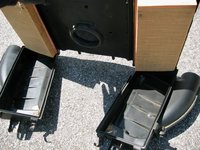






















































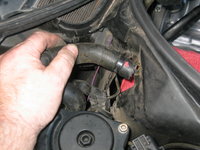


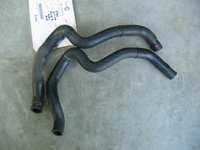



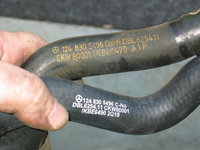


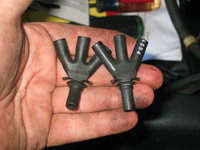


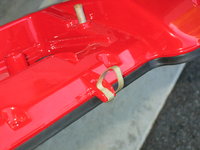


















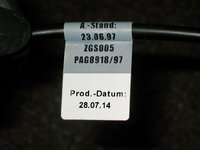


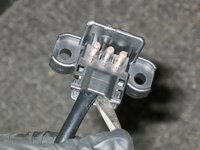










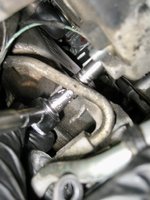


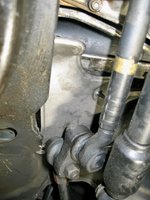





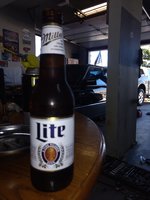

![[500Eboard] IMG_9389.jpeg [500Eboard] IMG_9389.jpeg](https://www.500eboard.co/forums/data/attachments/103/103622-d19fecae7658273f97c0d4345c54ffeb.jpg?hash=0Z_srnZYJz)
![[500Eboard] IMG_9392.jpeg [500Eboard] IMG_9392.jpeg](https://www.500eboard.co/forums/data/attachments/103/103623-b56303147a27e570183fab8dad406c2f.jpg?hash=tWMDFHon5X)
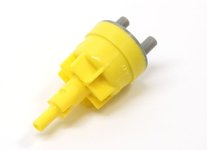













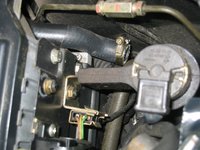







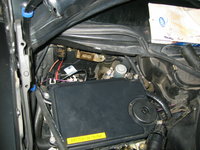


 -- added photographs
-- added photographs






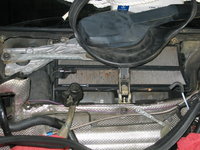






















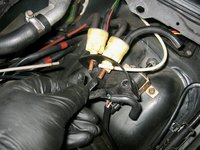

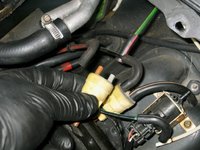







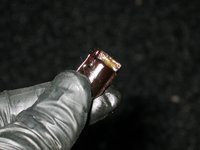


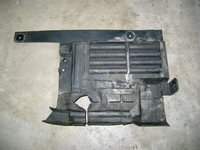
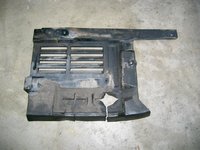
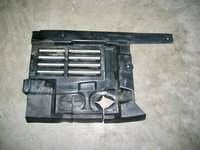
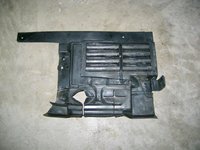

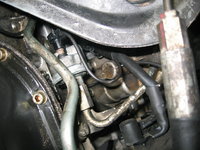

 But thankfully, I caught it before the
But thankfully, I caught it before the 

















































